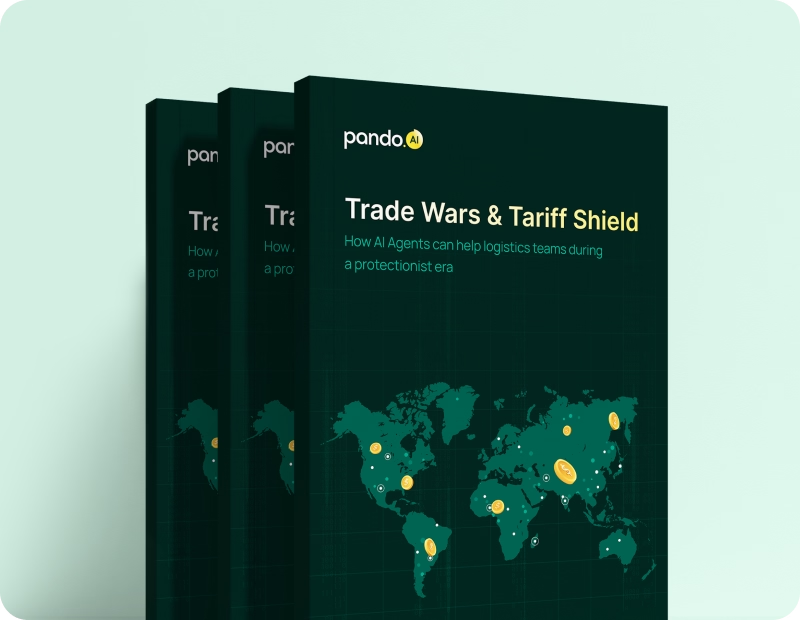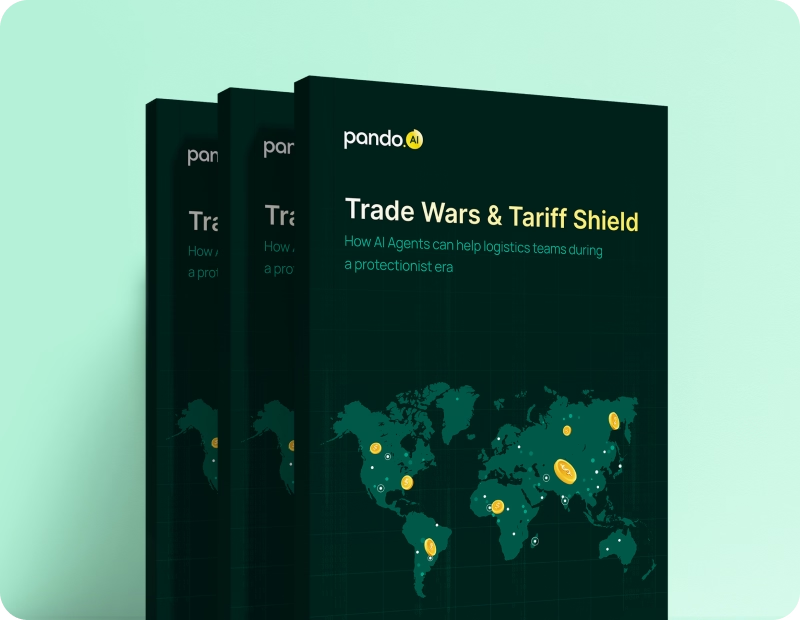-
Products Products
- Industry
- Initiatives
- Resources
- Company
- Book a demo

Before you go: Logistics leaders just dropped the truth on AI
The State of AI in Logistics 2025 is here — no hype, just real conversations and raw insights.
Liberation Day Tariffs: How Trump’s New Trade Policy Is Sending Shockwaves Across Global Logistics
Explore how "Liberation Day" tariffs announced by Trump on April 02, 2025 is reshaping global logistics.
Published on April 8, 2025 • 10 mins read
Sridhar C S

Explore how "Liberation Day" tariffs announced by Trump on April 02, 2025 is reshaping global logistics.
The global supply chain landscape changed dramatically on April 2, 2025. Standing in the White House Rose Garden, President Trump announced sweeping tariff changes he called “Liberation Day”—a policy shift that represents the most significant restructuring of U.S. trade relationships in nearly a century.
“This is our declaration of economic independence,” Trump stated as he unveiled tariffs that immediately sent ripples through global markets and supply chains. For logistics professionals, the implications are profound and far-reaching, requiring immediate strategic reassessment and operational adaptation.
This isn’t just another incremental policy adjustment. It’s a fundamental recalibration of the rules governing international trade—one that will test the resilience, agility, and technological capabilities of supply chains worldwide.
Understanding the new tariff structure: A multi-layered approach
The “Liberation Day” tariffs introduce unprecedented complexity into global trade through a multi-tiered structure that affects virtually all imports:
The baseline 10% tariff, effective April 5, establishes a new floor for all goods entering the United States. This universal tariff alone represents a significant shift, transforming previously duty-free transactions into taxable events and adding immediate costs to supply chains.
The country-specific “reciprocal” tariffs, effective April 9, create a complicated matrix of duty rates targeting countries with which the U.S. maintains large trade deficits. The administration calculated these rates based on what officials described as “discounted reciprocal” formulas that consider bilateral trade imbalances.

The results are striking. Asian manufacturing centers face particularly steep duties: China has received the heaviest of the tariffs, with 104% slapped across for all imports from there. Whereas China retaliated with an 84% tariff on all US goods. Cambodia (49%), Vietnam (46%), Thailand (36%), and Taiwan (32%) were also not spared in retaliatory tariffs. The European Union collectively faces a 20% tariff, while countries like the United Kingdom, Australia, and Brazil received the minimum 10% rate.
Adding further complexity, the administration imposed a 25% tariff on all imported automobiles and auto parts, maintained existing 25% tariffs on steel and aluminum imports, and established various exemptions for strategic products and regions.
USMCA-compliant goods from Canada and Mexico maintain duty-free status, though non-compliant goods face 25% tariffs. Certain product categories—including pharmaceuticals, semiconductors, copper, lumber, and strategic minerals—remain exempt from the higher reciprocal tariffs but still face the baseline 10% duty.
These overlapping tariff layers create an effective average U.S. tariff rate of approximately 25%—a level not seen since 1909. For logistics professionals, this means navigating the most complex duty structure in modern history.
The economic impact: Reshaping supply chain fundamentals
The ripple effects of these tariffs extend far beyond simple duty calculations. These new trade barriers are fundamentally altering the economic equations that have governed global supply chains for decades. According to economic analyses, the combined effect could reduce U.S. GDP by up to 1% and raise prices by 9.5%, transforming how businesses approach everything from sourcing to inventory management to transportation. As organizations absorb these changes, four critical areas of impact have emerged:
-
Margin compression throughout the value chain: For organizations accustomed to thin margins and just-in-time inventories, tariffs of this magnitude cannot simply be absorbed. The impact cascades throughout the supply chain, affecting sourcing decisions, transportation policies, and ultimately consumer prices.
-
Working capital requirements surge: As duties must be paid upon import, organizations face immediate cash flow impacts. Simultaneously, uncertainty around customs clearance times and potential retaliatory measures drives many companies to increase safety stock, further straining working capital.
-
Lead time volatility creates planning challenges: Customs processing times have become significantly more variable as officials implement the new multi-tiered system. This unpredictability undermines the precise scheduling that modern supply chains depend on, forcing companies to build additional time buffers into their planning.
-
Freight Capacity and Routing Adjustments: Distribution and transportation networks optimized for pre-tariff conditions may no longer be optimal. Companies are reassessing carrier selection, transportation routes, and modal choices to accommodate new trade patterns and reduce costs.
Industry-specific impacts: Varying challenges across sectors
While tariffs affect virtually all global trade, their impact manifests differently across industries. The unique supply chain structures, sourcing patterns, and operating models of each sector create distinct vulnerability profiles and response requirements. Analysis from industry experts shows that sectors with globally integrated supply chains, high import dependency, and complex manufacturing processes face the most significant disruption. Let’s examine how five key industries are navigating these unprecedented challenges.
Automotive manufacturing: A perfect storm
The automotive industry confronts perhaps the most challenging scenario: 25% tariffs on imported vehicles and parts, layered on top of country-specific tariffs on major component manufacturing hubs. This combination creates multiple pressure points.
The industry’s global integration means many vehicles cross borders multiple times during production. A single vehicle might contain components from dozens of countries, each potentially subject to different tariff rates.
Just-in-time manufacturing systems—the backbone of modern automotive production—become vulnerable when customs clearance times grow unpredictable. Assembly lines designed with minimal buffer stocks risk costly shutdowns when components are delayed.
Major manufacturers report potential price increases between $4,000-$10,000 per vehicle depending on sourcing locations and import content. These increases threaten to significantly reduce consumer demand in an already cooling market.
Engineers are racing to redesign components to use domestically available alternatives, but complete localization could take years and billions in capital investment.
Pharmaceutical industry: Supply security concerns
Though pharmaceuticals themselves are exempt from the higher reciprocal tariffs, the industry still faces significant challenges.
For example, Pharmaceutical ingredients sourced from India faces a 10.09% tariff differential, affecting production economics for many medications. With already thin margins on many generic drugs, these additional costs could impact availability.
Documentation requirements have increased substantially as customs officials seek to verify pharmaceutical classifications. This creates administrative burdens and potential clearance delays for time-sensitive shipments.
Supply security concerns have intensified, with pharmaceutical companies accelerating plans to diversify sourcing beyond traditional hubs in China and India. This transition requires substantial regulatory work and validation testing.
Chemical manufacturing: Global integration challenged
The chemical industry’s highly integrated global operations make it uniquely vulnerable to the new tariff structure. The current Trump administration has spared many important chemicals from the retaliatory tariff approach. However, there is still an air of uncertainty as chemical manufacturers are worried about how ocean shipping rules would affect cross-border commerce. This is critical in the modern context as many specialty chemicals cross borders and travel great distances multiple times during production.
Reformulation efforts are accelerating, with R&D teams working to substitute domestically available alternatives for imported precursors and additives. However, these substitutions require extensive testing and often regulatory approvals. Downstream manufacturing faces higher input costs for chemical components, creating cascading effects through industrial supply chains. Adhesives, coatings, and specialty materials used across industries all face price pressures.
Safety stock requirements for hazardous or highly regulated materials add further complexity, as buffer inventories must balance tariff-induced cost increases against regulatory storage limitations.
Retail and consumer products: Direct consumer impact
Retailers and consumer products companies face immediate inventory and pricing challenges with direct consumer implications:
Many staple consumer goods—from apparel to electronics to household items—come from high-tariff countries like China and Vietnam. These products can face cost increases of 10-50%, forcing difficult pricing decisions. Seasonal planning, already complex, becomes more challenging with uncertain clearance timelines. Holiday merchandise typically ordered 6-9 months in advance now carries significant tariff risk if policies change during production.
Inventory management strategies require recalibration as the cost of carrying inventory increases while the risk of stockouts grows due to clearance variability. Possible delays in transportation or even countries backing out of trade deals may force retailers to make difficult trade-offs between service levels and capital efficiency.
Omnichannel fulfillment grows more complex as imported goods face varying landed costs depending on entry point and classification. This complicates inventory allocation and margin management across channels.
Strategic imperatives: Building supply chain resilience
The unprecedented scale and complexity of these tariffs demand more than tactical responses—they require strategic transformation of supply chain capabilities. Research from the Center for Strategic and International Studies indicates that organizations with advanced analytical capabilities, network flexibility, and real-time visibility are significantly better positioned to mitigate tariff impacts. To navigate this new landscape effectively, logistics leaders must prioritize four critical capability areas:
-
Total landed cost analysis: The multi-layered tariff structure demands sophisticated modeling that captures all cost elements—duties, freight, inventory carrying costs, compliance expenses, and lead time implications. Companies must treat tariffs as a reality that is alarmingly reshaping global logistics. Instead of approaching tariffs as standalone entities, it is imperative to consider them a key component within a larger logistics strategy. This comprehensive approach allows organizations to make decisions based on total landed cost rather than reacting solely to duty rates.
-
Transportation mode and lane optimization: With tariffs fundamentally altering the cost equation of international goods movement, selecting the right transportation modes and lanes becomes a critical strategic decision. According to shipping analysts, organizations that monitor current trade routes and understand market trends can find significant opportunities in the falling ocean container shipping market, despite rising tariffs.

-
Transit time reliability and planning: Safety stock levels, delivery timeframes, and transportation planning all require adjustment based on new customs clearance variability and lead time uncertainty. According to industry reports, businesses are finding that tariffs are forcing companies to rethink their entire approach to delivery timing and reliability. For many organizations, this means investing in more contract manufacturing within the US for high-tech products to maintain delivery consistency despite uncertain import conditions.
-
Advanced visibility requirements: Real-time insight into shipment status, customs clearance progress, and inventory positions becomes essential for managing variability. Traditional milestone-based tracking no longer provides the granularity needed to manage exceptions effectively.
These imperatives highlight the need for sophisticated technological capabilities that enable organizations to navigate the new tariff landscape successfully.
Conclusion: Navigating the new trade reality
The “Liberation Day” tariffs represent more than just another policy change—they signal a fundamental shift in the global trade environment that requires a corresponding evolution in supply chain strategies.
Organizations that approach this challenge tactically—simply calculating new duty rates or seeking short-term workarounds—will likely struggle as the situation continues to evolve. Success requires a more strategic approach that views tariffs as one element within a broader supply chain optimization framework.
The path forward demands enhanced visibility, sophisticated analytics, and agile decision-making capabilities. These tools enable organizations to continuously optimize their supply chains as conditions evolve, turning potential disruption into competitive advantage.
In our next blog, we’ll explore how our AI agent for logistics, Pi, is helping organizations navigate these challenges and build more resilient supply chains in the face of unprecedented trade policy changes.
Stay tuned for Part 2: “Beyond tariffs: How Pi - Our AI agent for logistics can transform logistics in the new trade reality”
Subscribe to Pando blog and Crossroads newsletter now!
Stay up to date with the latest logistics, transportation, and supply chain tips and news.
Subscribe Here!













